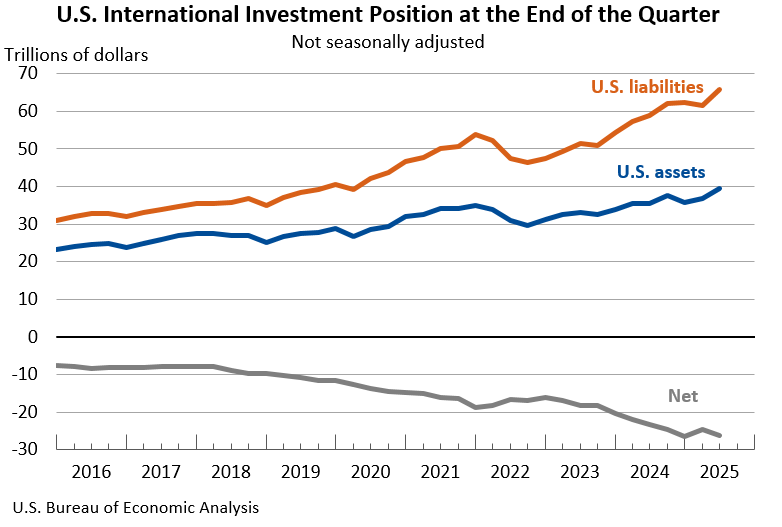Notice
Due to a lapse in appropriations, this website is not being updated.
Bureau of Economic Analysis
U.S. International Investment Position, 2nd Quarter 2025
The U.S. net international investment position, the difference between U.S. residents’ foreign financial assets and liabilities, was -$26.14 trillion at the end of the second quarter of 2025, according to statistics released today by the U.S. Bureau of Economic Analysis. Assets totaled $39.56 trillion, and liabilities were $65.71 trillion. At the end of the first quarter, the net investment position was -$24.65 trillion (revised).
Principal Federal Economic Indicators
Noteworthy
The Latest
GDP Increases in Second Quarter
Real gross domestic product (GDP) increased 4.2 percent in the second quarter of 2018, according to the “second” estimate released by the Bureau of Economic Analysis. The growth rate was 0.1 percentage point more than the “advance” estimate released in July. In the first quarter, real GDP increased 2.2 percent.
GDP highlights
Gross Domestic Product: Second Quarter 2018 (Second Estimate); Corporate Profits: Second Quarter 2018 (Preliminary Estimate)
Real gross domestic product (GDP) increased 4.2 percent in the second quarter of 2018, according to the “second” estimate released by the Bureau of Economic Analysis. The growth rate was 0.1 percentage point more than the “advance” estimate released in July. In the first quarter, real GDP increased 2.2 percent.
Late BE-120 Filers Must File by Sept. 28
BEA will soon be mailing delinquency letters to businesses and others that have not submitted their responses to the 2017 BE-120 survey, the Benchmark Survey of Transactions in Selected Services and Intellectual Property with Foreign Persons.
American Samoa GDP Decreases in 2017
The estimates of GDP for American Samoa show that real GDP—GDP adjusted to remove price changes—decreased 5.3 percent in 2017 after decreasing 2.7 percent in 2016. For comparison, real GDP for the United States (excluding the territories) increased 2.2 percent in 2017 after increasing 1.6 percent in 2016.
American Samoa GDP Decreases in 2017
The Bureau of Economic Analysis released estimates of gross domestic product for American Samoa for 2017, in addition to estimates of GDP by industry and compensation by industry for 2016. These estimates were developed under the Statistical Improvement Program funded by the Office of Insular Affairs of the U.S. Department of the Interior.
Revised estimates of GDP for 2015 and 2016, as well as revised estimates of GDP…
Activities of U.S. Multinational Enterprises: 2016
Worldwide employment by U.S. multinational enterprises (MNEs) increased 0.4 percent to 42.3 million workers (preliminary) in 2016 from 42.1 million (revised) in 2015.
Activities of U.S. Multinational Enterprises: 2016
Worldwide employment by U.S. multinational enterprises (MNEs) increased 0.4 percent to 42.3 million workers (preliminary) in 2016 from 42.1 million (revised) in 2015, according to statistics released by the Bureau of Economic Analysis on the operations and finances of U.S. parent companies and their foreign affiliates.
SCB Article: Results of Seasonal Adjustment Project
With its 2018 comprehensive update of gross domestic product and related statistics, the Bureau of Economic Analysis completed a multiyear project to improve and modernize our seasonal adjustment practices.
Welcome to the Updated bea.gov
We’ve made it easier to find what you’re looking for.
Our redesigned homepage features BEA’s latest news and most-watched statistics.
Use the Data menu at the top to explore data by topic or by place.
Want to dive straight into the numbers? The Tools menu takes you to our expansive Interactive Data Tables, the API, and other data tools. (They function the same as before, although they are found at the new…
June 2018 Trade Gap is $46.3 Billion
The U.S. monthly international trade deficit increased in June 2018 according to the U.S. Bureau of Economic Analysis and the U.S. Census Bureau. The deficit increased from $43.2 billion in May (revised) to $46.3 billion in June, as exports decreased and imports increased. The previously published May deficit was $43.1 billion. The goods deficit increased $3.1 billion in June to $68.8 billion. The services surplus decreased less than $0.1…




